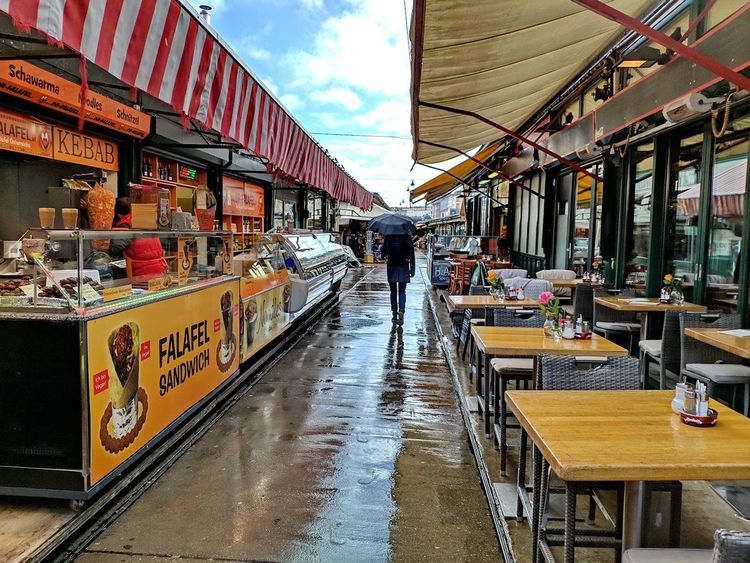Naschmarkt Vienna

Naschmarkt Vienna: A Culinary and Cultural Gem
Naschmarkt, Vienna's most famous and beloved market, offers a vibrant and diverse experience for both locals and tourists. Located in the heart of the city along the Wienzeile, this historic market stretches over 1.5 kilometers and is a bustling hub of activity. With its eclectic mix of fresh produce, exotic spices, international cuisine, and a lively flea market, Naschmarkt is a must-visit destination for anyone exploring Vienna. This article delves into the history, key attractions, and practical tips for visiting Naschmarkt, providing a comprehensive guide for those planning to immerse themselves in this dynamic market.
History of Naschmarkt
Naschmarkt's origins date back to the 16th century when it began as a simple farmers' market. Initially, it was known as the Aschenmarkt, named after the wooden boxes (Aschen) used by the vendors. Over the centuries, the market evolved and expanded, eventually being renamed Naschmarkt. By the 19th century, it had become the central market for Vienna, offering a wide array of goods and attracting vendors from all over the region.
Key Attractions
1. Fresh Produce and Specialty Foods
Naschmarkt is renowned for its extensive selection of fresh fruits and vegetables, sourced from local farms and international suppliers. Visitors can find seasonal produce, organic options, and exotic fruits and vegetables that are hard to find elsewhere in Vienna. In addition to fresh produce, the market is a paradise for food enthusiasts, offering a variety of specialty foods such as cheeses, meats, seafood, and baked goods.
2. International Cuisine
One of the highlights of Naschmarkt is its diverse range of international cuisine. The market is home to numerous food stalls, cafes, and restaurants serving dishes from around the world. From traditional Austrian delicacies to Middle Eastern, Asian, and Mediterranean fare, there is something to satisfy every palate. Popular options include falafel, sushi, kebabs, tapas, and more. Many of these eateries offer outdoor seating, allowing visitors to enjoy their meals while soaking in the vibrant atmosphere of the market.
3. Spices and Herbs
Naschmarkt is a treasure trove for those who love to cook. The market features numerous stalls selling a vast array of spices and herbs from all corners of the globe. Whether you're looking for saffron from Iran, curry powders from India, or local Austrian herbs, you'll find it here. These stalls also offer dried fruits, nuts, and specialty oils, making it a one-stop shop for all your culinary needs.
4. Flea Market
Every Saturday, Naschmarkt hosts a lively flea market at its western end. This bustling event is a favorite among locals and tourists alike, offering an eclectic mix of antiques, vintage items, clothing, books, and bric-a-brac. It's the perfect place to hunt for unique souvenirs and treasures. The flea market is a great way to experience the local culture and engage with vendors who are often eager to share the stories behind their wares.
5. Viennese Delights
While Naschmarkt is known for its international offerings, it also boasts an impressive selection of traditional Viennese foods. Visitors can sample local favorites such as Wiener Schnitzel, Sachertorte, and Apfelstrudel. Several stalls and restaurants specialize in Austrian cuisine, providing an authentic taste of Vienna's culinary heritage. Don't miss the chance to try some of the market's famous pickles, cured meats, and freshly baked pastries.
Practical Tips for Visiting Naschmarkt
1. Best Time to Visit
Naschmarkt is open Monday to Saturday, with most vendors starting their day around 6 AM and closing by 7 PM. Saturdays are particularly lively due to the flea market, but they can also be crowded. For a more relaxed experience, consider visiting during the weekdays or early in the morning when the market is less busy.
2. Navigating the Market
Naschmarkt is divided into sections, with the western end dedicated to the flea market and the eastern end hosting the food stalls and restaurants. It's a good idea to start your visit at one end and make your way through the market to ensure you don't miss any of the highlights. Comfortable walking shoes are recommended, as the market spans a considerable distance.
3. Engaging with Vendors
Most vendors at Naschmarkt are friendly and welcoming, happy to offer samples and share their knowledge of the products they sell. Don't hesitate to ask questions or seek recommendations. Many vendors speak English, but learning a few basic German phrases can enhance your experience.
4. Payment and Bargaining
While many stalls accept credit cards, it's advisable to carry some cash, especially when shopping at the flea market. Bargaining is not common practice in the food section, but you might try your luck at the flea market, where haggling is more acceptable.
5. Sustainability and Eco-Friendly Options
Naschmarkt is increasingly embracing sustainability, with several vendors offering organic and eco-friendly products. Look for stalls that promote local and sustainable practices, and consider bringing your own reusable bags to minimize plastic waste.
Conclusion
Naschmarkt is more than just a market; it's a vibrant cultural experience that captures the essence of Vienna's diverse and dynamic spirit. From its rich history and stunning array of fresh produce to its international cuisine and lively flea market, Naschmarkt offers something for everyone. Whether you're a food lover, a history buff, or simply looking to soak in the local atmosphere, a visit to Naschmarkt is a must on any Vienna itinerary. Plan your trip, explore the stalls, and immerse yourself in the sights, sounds, and flavors of this iconic Viennese market.